- CONDUCTING COLOURS
- See ‘colours 5)’.


Naval Ensign, UK; Naval Ensign
South Africa 1952–1981
- CONE(S)
- A term sometimes used in place of upright triangle, and often when two or
more are seen together – see ‘triangle 2)’.

National Flag of St. Lucia
- CONE FLAG
- The newly introduced term for a rigid cone-like object in flag design
which is to be hoisted on a (usually) indoor pole – see flagpole (also
vexilloid 1)).

Image source: Facebook
- CONE TAPERED
- A simplified form of the Venetian entasis taper in which a flag pole tapers evenly from its
base to the truck – but see ‘Venetian entasis taper’
(also ‘flag pole’ and
‘truck’).
- CONFANONERIUS
- A medieval term, now obsolete, for a
‘standard bearer’.
- CONFANONUM (or CONFARONUM)
- Medieval terms, now obsolete, for a ‘gonfanon’.

Gonfanonun/Gonfanon of Eustache III of Auvergne c1100
- CONFRONTING
- A heraldic term sometimes used in place of affrontant, respectant or combatant – see affrontant,
combatant and respectant.
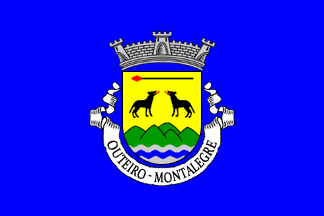
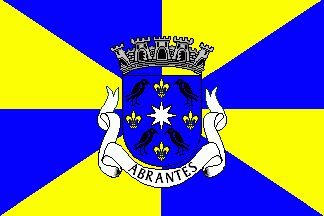
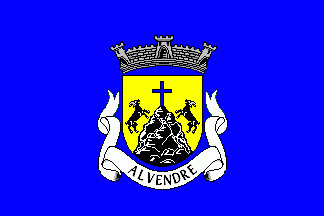
Flag of Outeiro, Portugal;
Flag of Abrantes, Portugal; Flag of Alvendre, Portugal
- CONJECTURAL IMAGE (or FLAG)
- See ‘reconstruction’.


Two Conjectural/Reconstructed Images of the Bauceant
- CONJOINED (or CONJUNCT)
- Alternative heraldic terms used when two or more charges are joined together so as to touch each
other – conjunct, or joinant (see also ‘charge 1)’)
and ‘interlaced’.
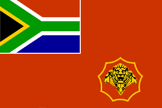

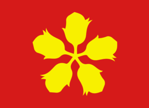
Flag and Emblem of the Army,
South Africa;
Flag of Hemne, Norway
Please note – not to be confused with two sets of arms, or
elements from those arms, which are impaled by dimidiation – see
'dimidiated' and following note.
- CONNECTED
- In heraldry see ‘conjoined’.


Flag and Arms of Nœrøy, Norway
- CONOISSANSE
- In heraldry see ‘cognisance’ 2)’.
- CONSECRATION
- The usually religious ceremony at which a new military or other ceremonial colour is
dedicated – a service or ceremony of consecration or the blessing of a flag (see also
‘colour 2)’ and ‘parade flag’).
Please note that a ceremony of consecration – particularly that
of some non-military colours – may also include the honouring of an individual with the title
of God Parent to the flag involved – see ‘flag patron’).
- CONSECRATION CROSS
- See ‘rounded cross’.

Putative Banner of the Portuguese Knights Templar
- CONSTRUCTION SHEET
- See ‘specification sheet’.

Construction/Specification Sheet for the National Flag of
Qatar
- CONSULAR (CONSULAR OFFICER’S or CONSUL’S) FLAG
- See ‘diplomatic flags’.
![[UK consular flag]](../images/v/vxt-d3668.gif)
![[UK consular flag]](../images/v/vxt-d568a.gif)
![[Thai consular flag]](../images/v/vxt-d2114.gif)
Consular Officer’s Flags Ashore and Afloat, UK; Consular Flag,
Thailand
- CONTINENTAL COLORS (or COLOURS)
- The first version of what later became the US national flag whose canton consisted
of the British 1606 pattern union jack rather than white stars on a blue field, and
in unofficial use from 1775 to 1777 – the grand (or occasionally “great”) union,
or Cambridge flag
(see also ‘Betsy Ross flag’,
‘British flag’,
‘Franklin flag’,
‘great star flags’,
‘gridiron flag’,
‘old glory’,
‘quincunx’,
‘star-spangled banner’
and ‘stars and stripes’).

The Continental Colors, US
- CONTOURNÉ
- The heraldic term used when an animal is facing towards the sinister rather than the usual dexter
– transversed – but see note below.
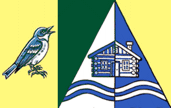
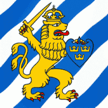

Flag of Mulgrave-et-Derry, Canada;
Flag of Gothenburg, Sweden;
Flag of Saint-Pierre, France
Please note that English sources restrict this term to the attitude of animals, however, European heraldry (and Scottish heraldic authority) also apply it to inanimate charges as illustrated above.
- CONVENTIONAL FLAG
- See ‘hoisted flag’.
- CONVERGING STRIPE(S)
- A term that may be used when a stripe or stripes narrow from the hoist to
the fly and finish at one fixed point (or two closely spaced points) as in,
for example, several maritime/naval pennants – but see 'expanding stripe(s)'
(also 'burgee', 'masthead pennant 1)', 'stripe(s)' and 'striped')."



Burgee of the Jedriličarski klub "Split", Croatia; Squadron Commander’s Pennant c1929, Uruguay; Masthead Pennant,
Croatia
Notes
a) This is not an established term, but has been introduced by the
Editors as no properly accurate and established alternative could be found.
b) The Editors also consider that this term should be retained to
describe a pennant or streamer that narrows towards the fly, and that a rectangular flag
(as illustrated below) whose stripes narrow in the same way, whilst uncommon, should be
classed as having 'expanding stripes' – see ‘expanding stripes’.

A Flag of Amarante do Maranhão, Brazil
- CONVOY FLAG
- See ‘fanion 2)’.



Three Convoy Flags/Fanions According to NATO Regulations















![[UK consular flag]](../images/v/vxt-d3668.gif)
![[UK consular flag]](../images/v/vxt-d568a.gif)
![[Thai consular flag]](../images/v/vxt-d2114.gif)













